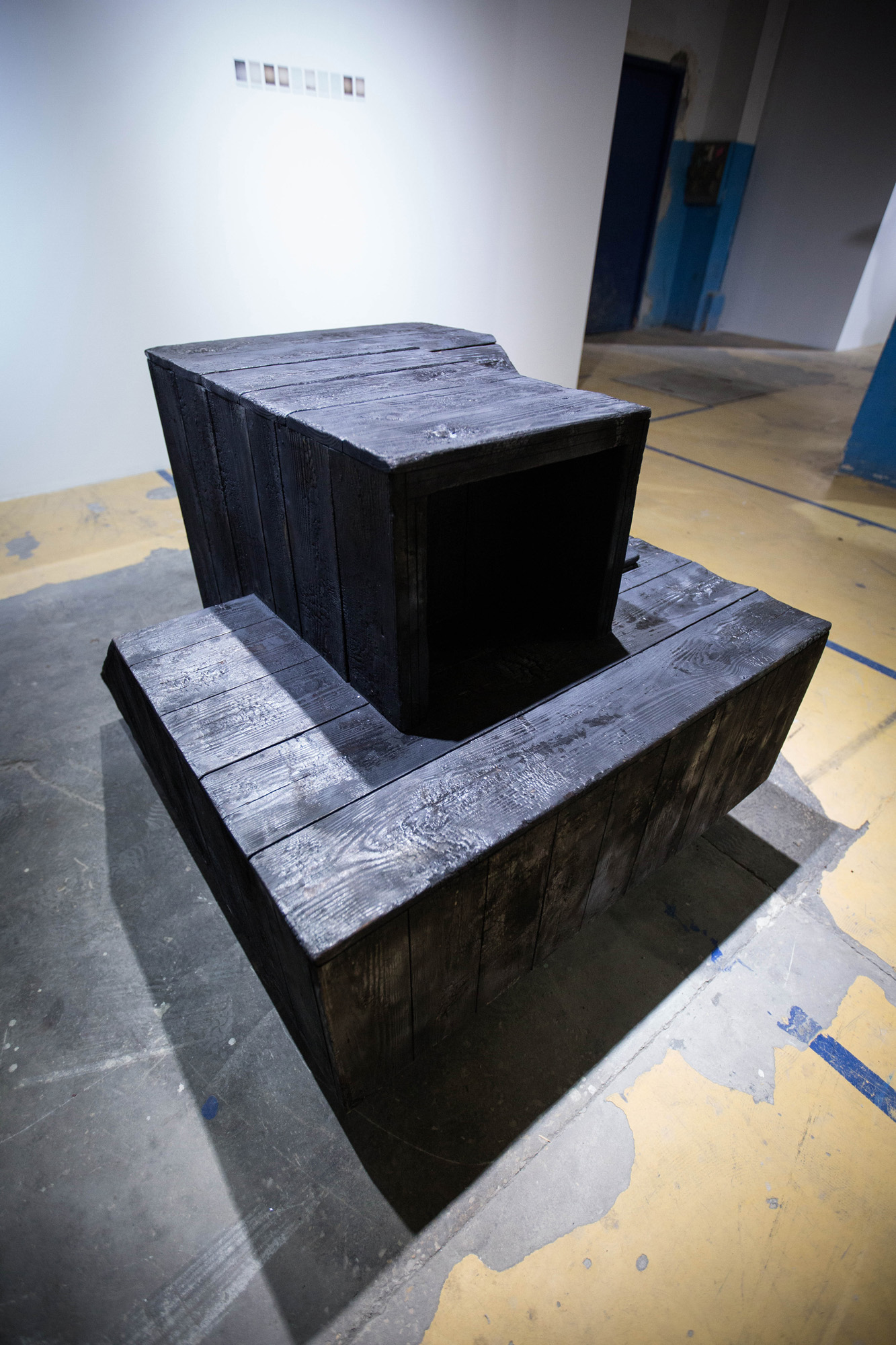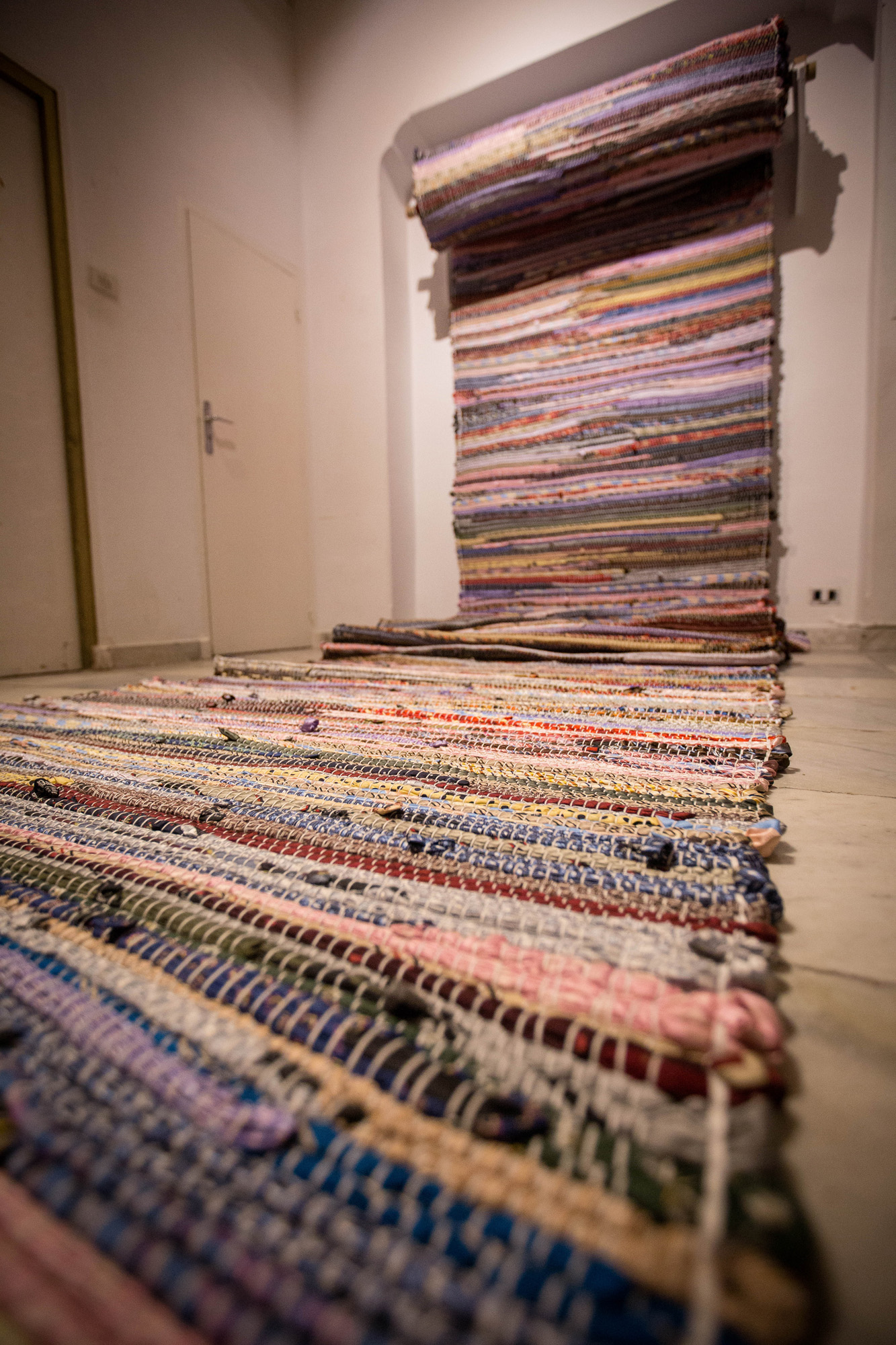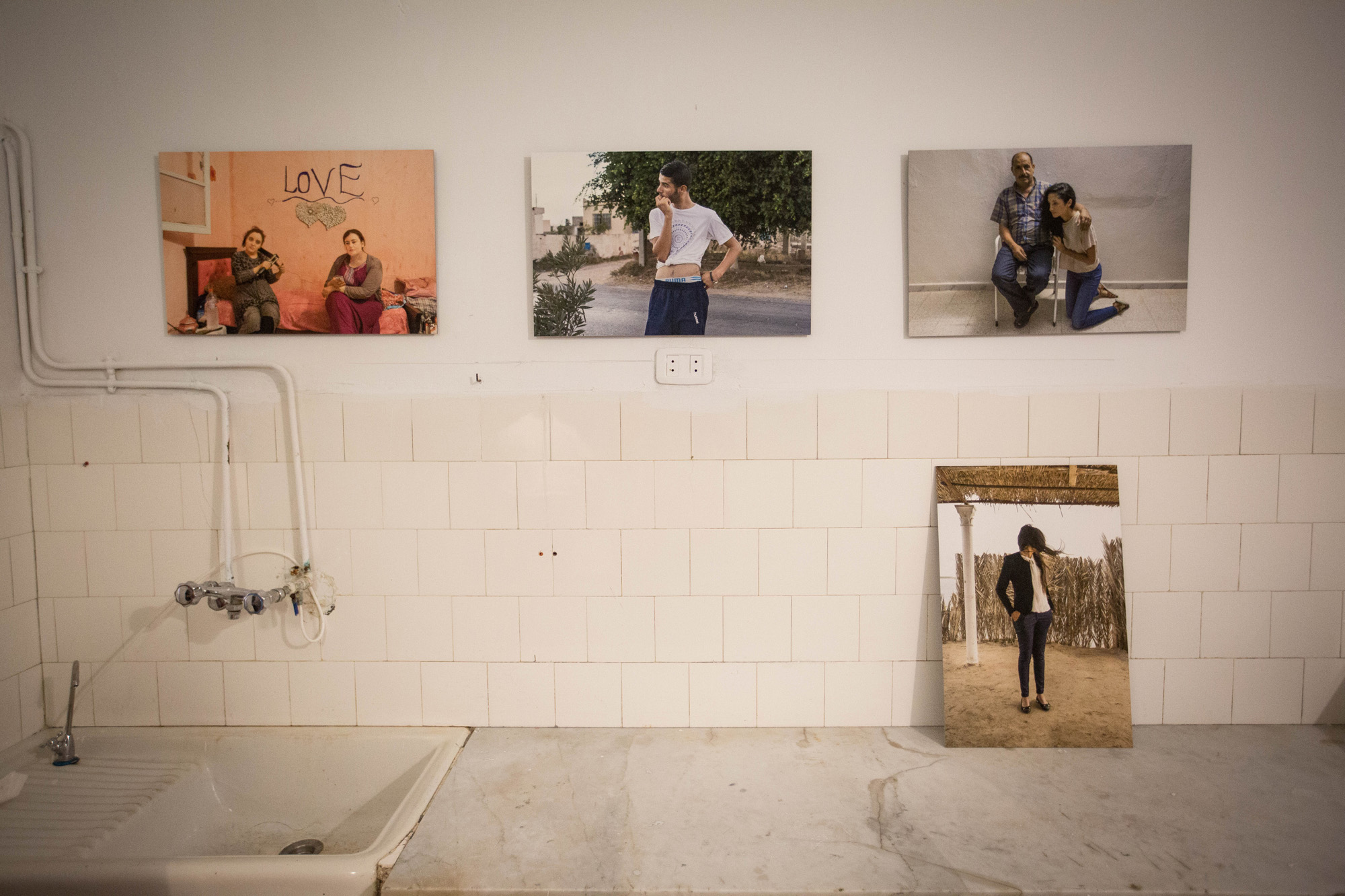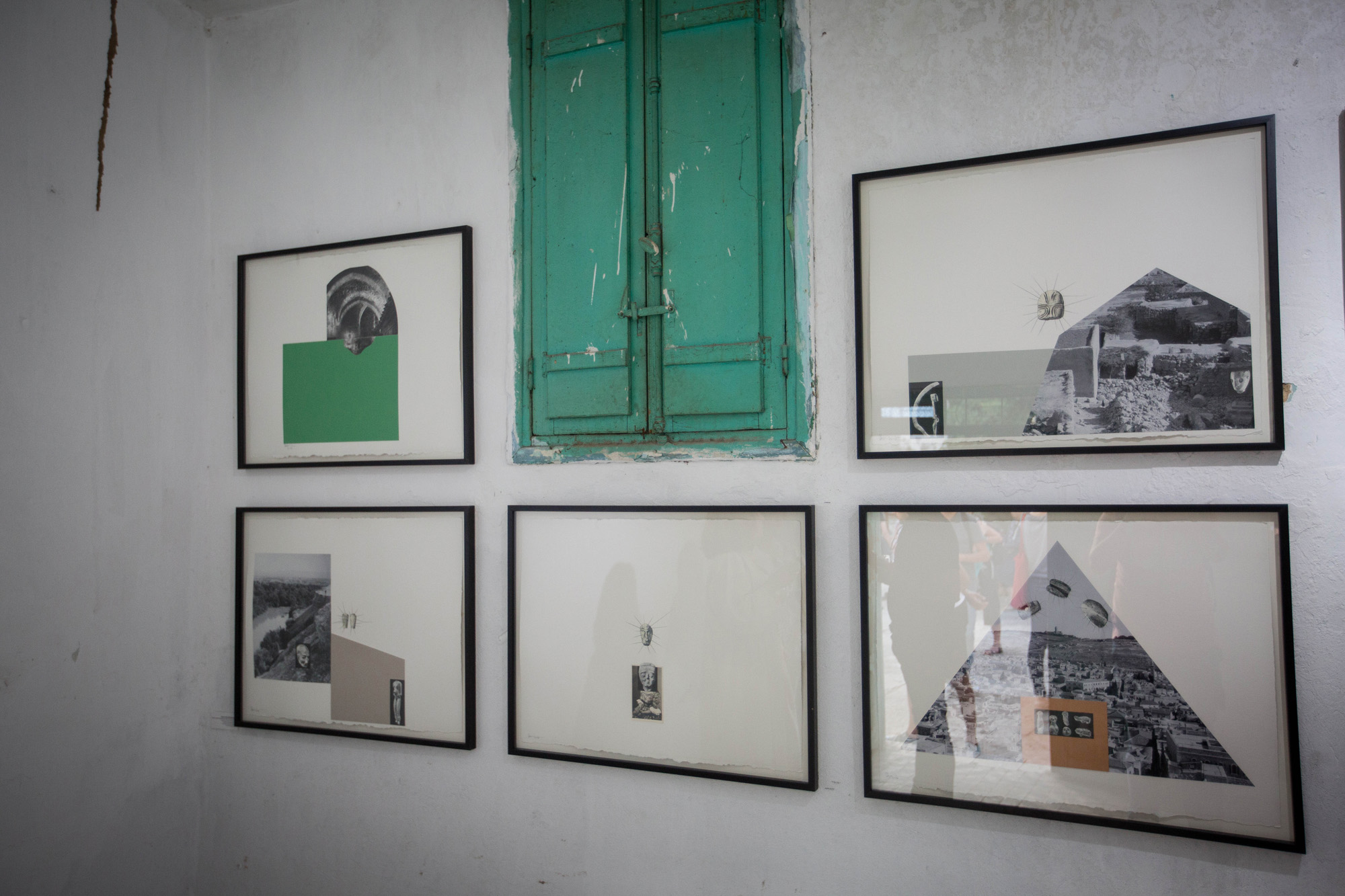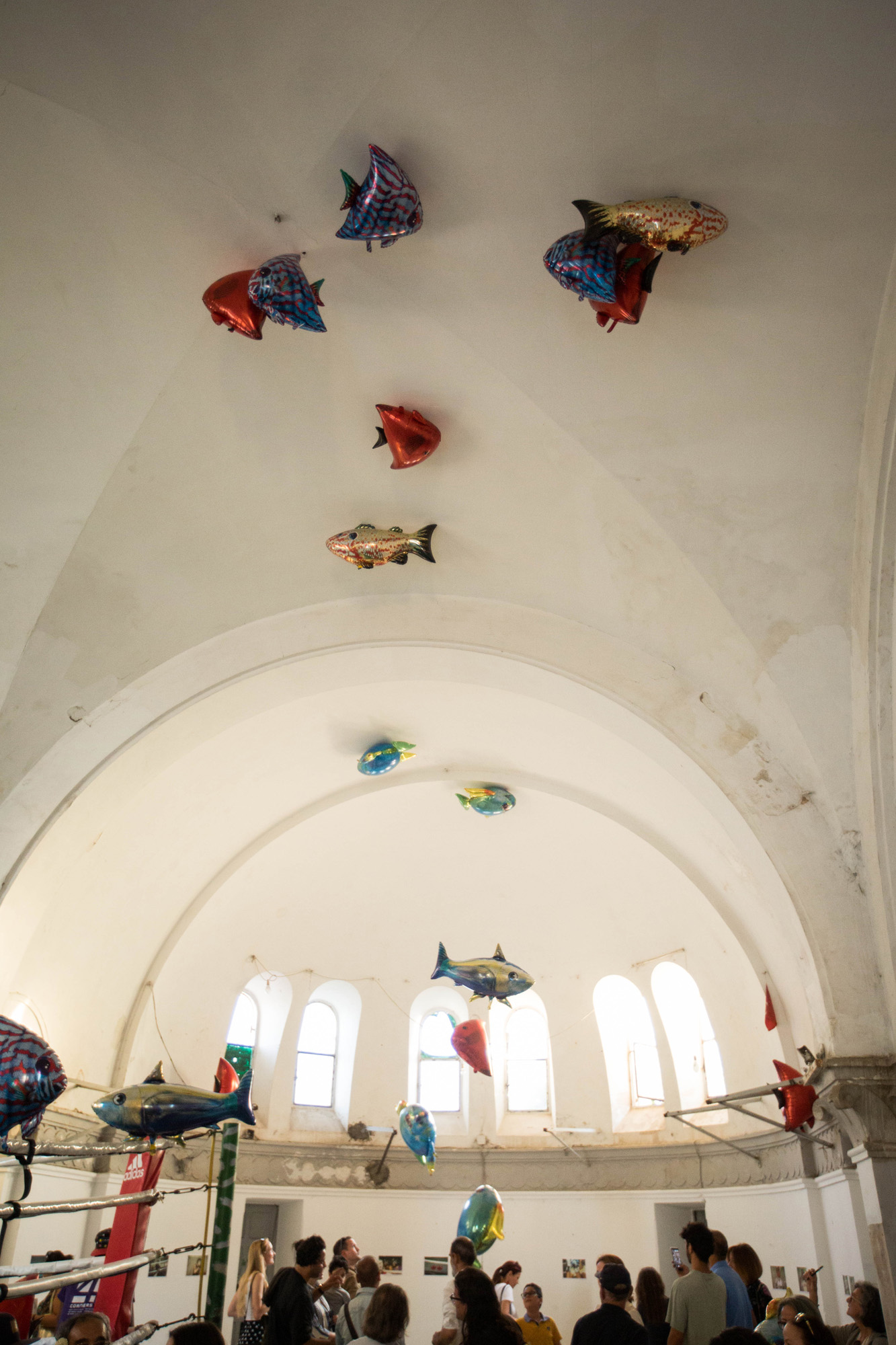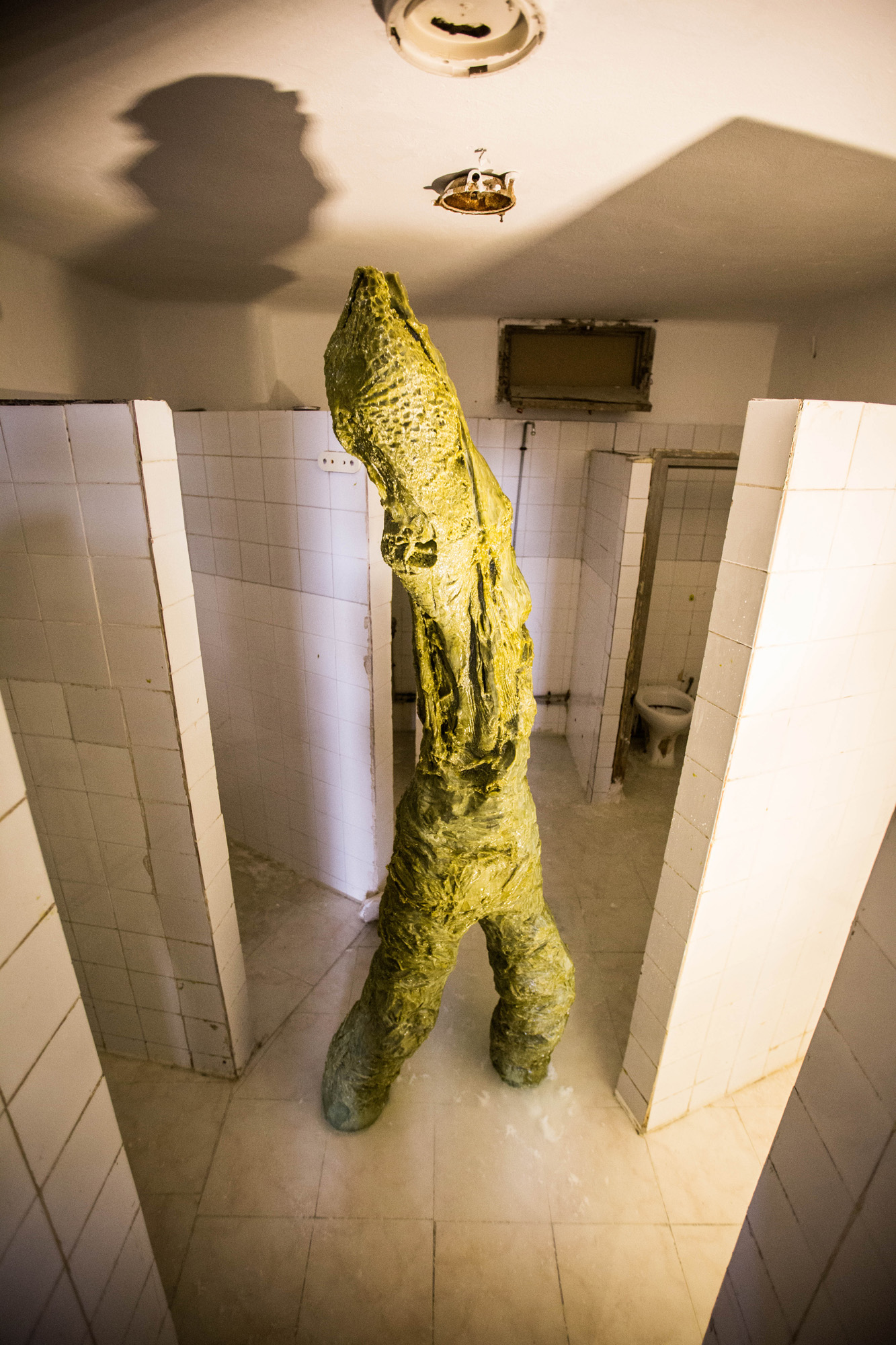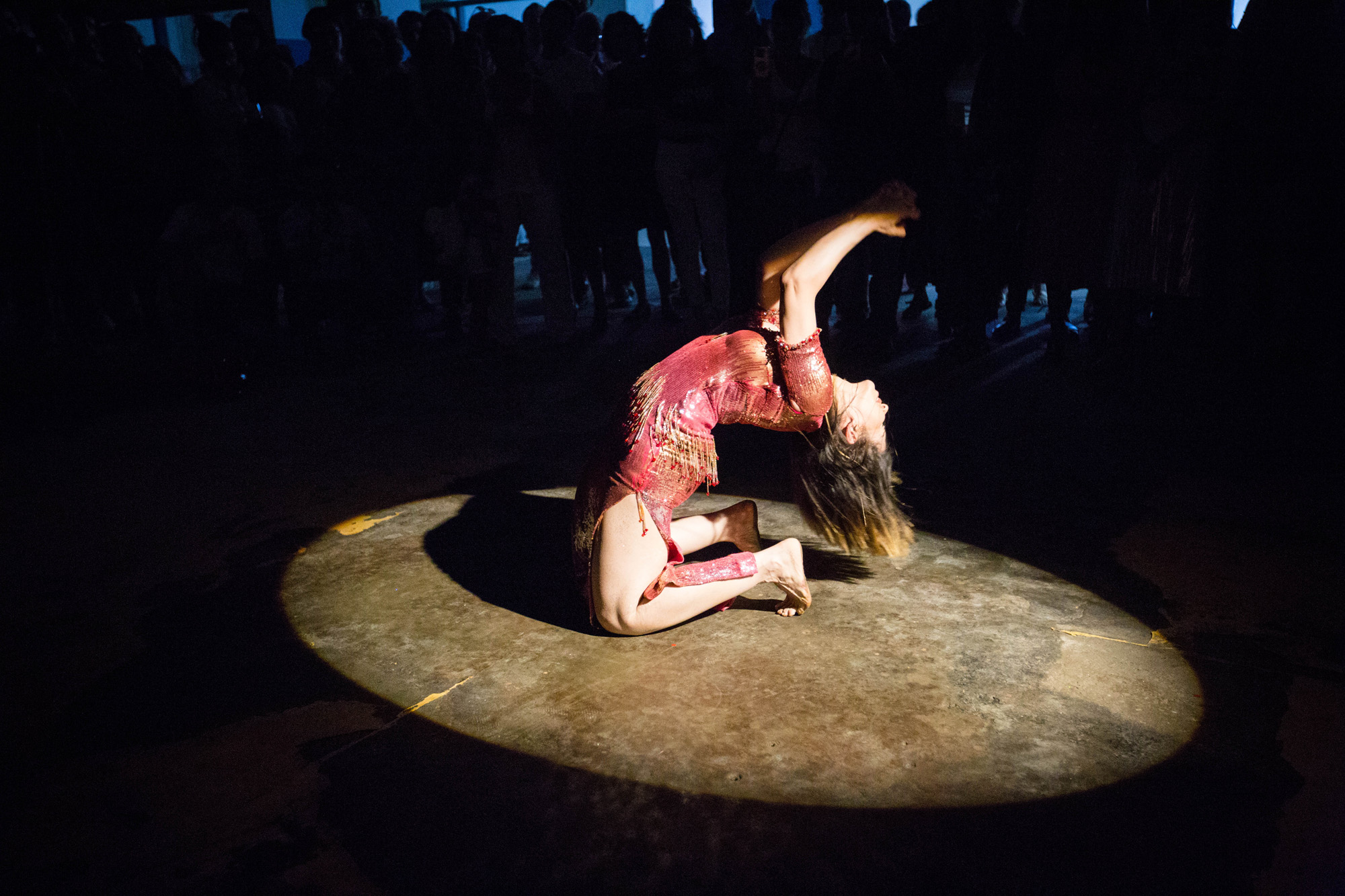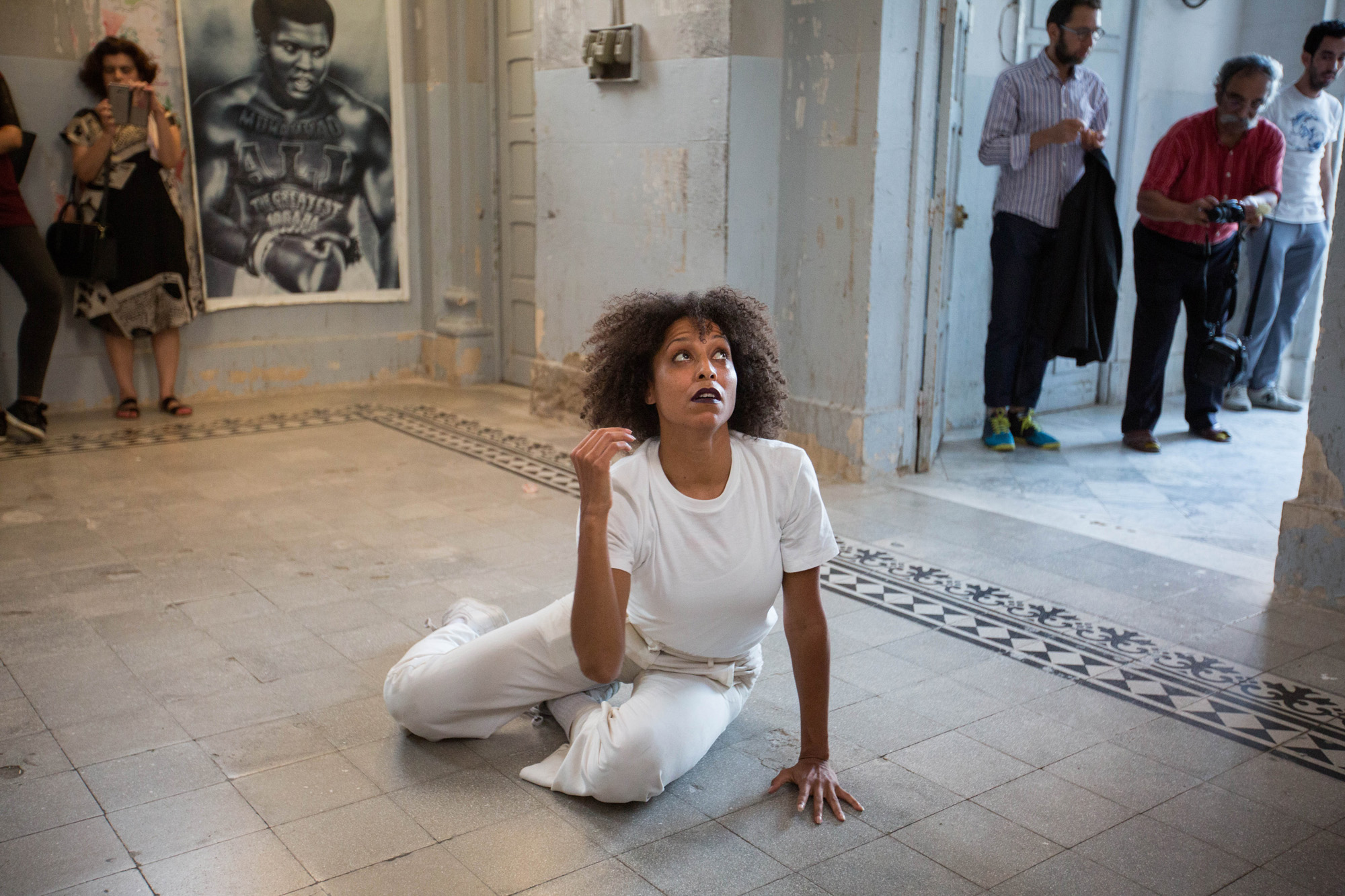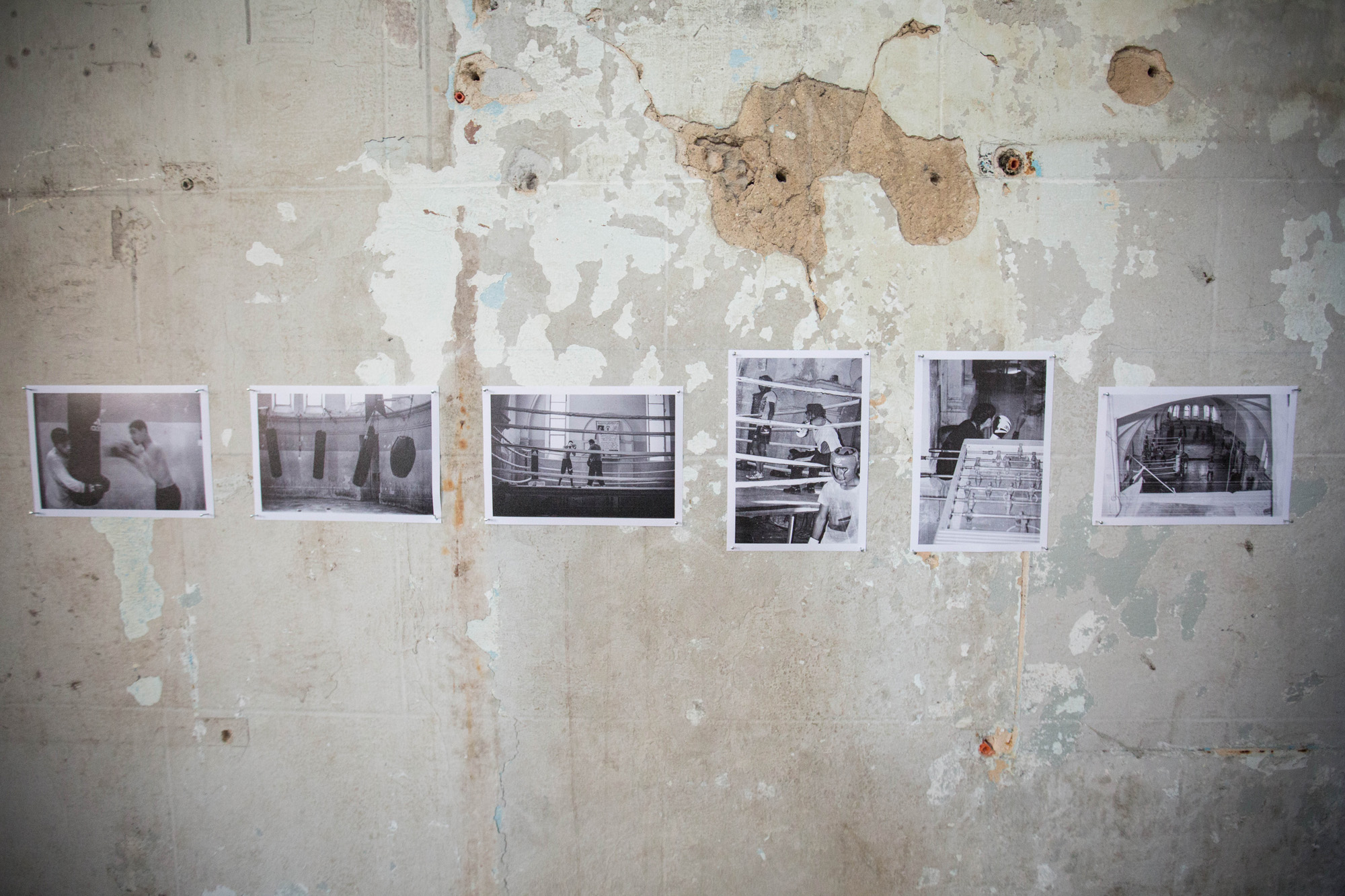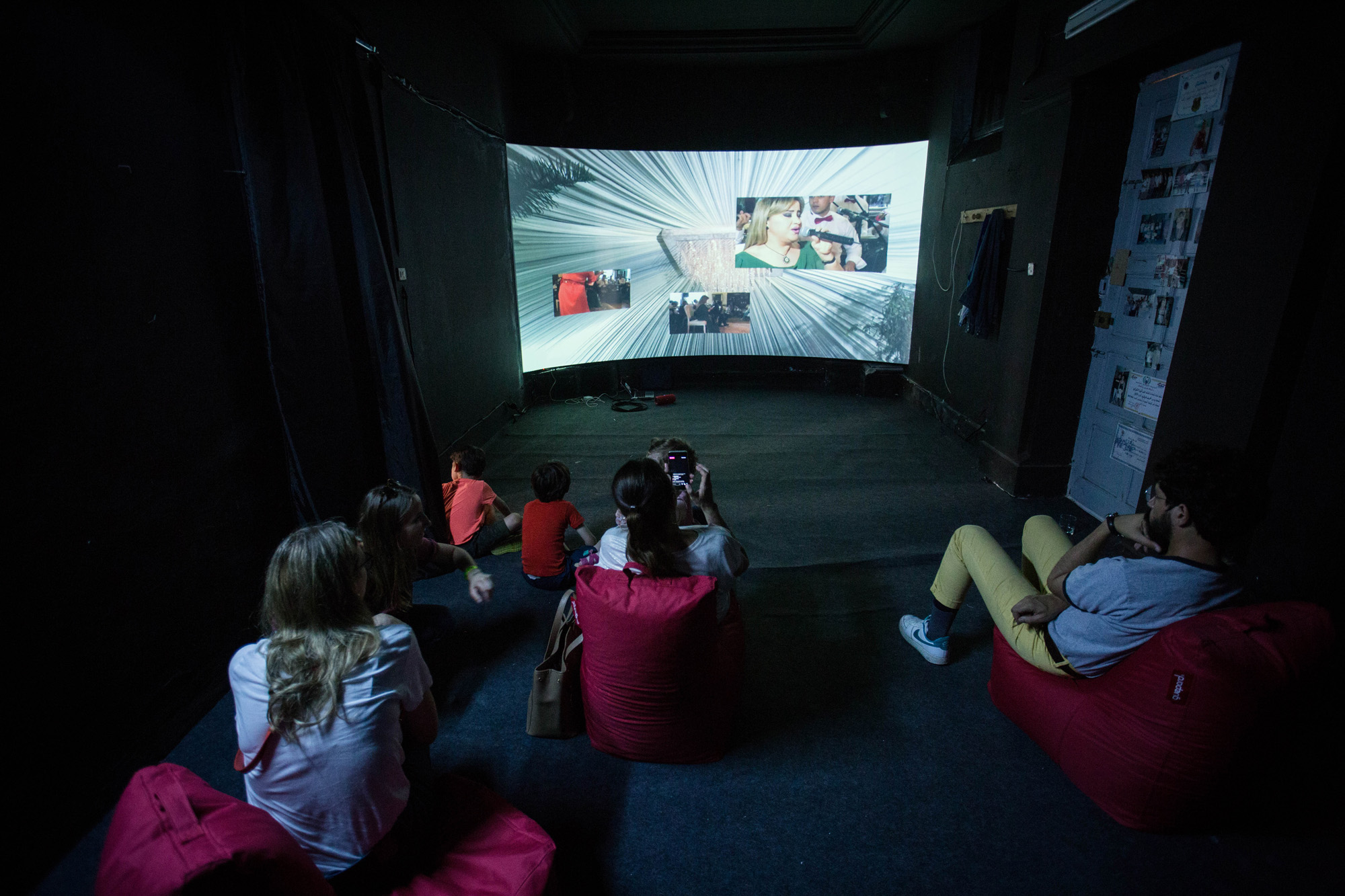Artists from the MENA region were in their element at this year’s Jaou Tunis
I’m in a crumbling, de-sanctified church surrounded by a shoal of helium balloons in the shape of tropical fish. They bob nonchalantly through the warm evening air, their tantalisingly bright shapes floating roof-ward out of reach. To my left is a well-worn boxing ring, eerily free of sparring bodies, and through a broken doorway into a tiled bathroom stands a life-sized green soap beast, its legs slowly turning to suds on the wet floor. In another room, this one empty and dusty, is nothing but a pile of sneakers and the audible sounds of hard breathing - the ghosts of boxers past? And pushing past a makeshift black curtain reveals a wondrous sight – projected onto the walls of this darkened vestry is a film scene of three raven haired, buxom women, all wearing canary yellow gowns and dancing like there’s no tomorrow.
Welcome to the brilliantly experimental world of Jaou Tunis. The event was first launched in Tunisia in 2013 by Lina Lazaar, vice president of the philanthropic Kamel Lazaar Foundation, as a means of promoting a contemporary art dialogue across the MENA region, and has grown in scope and ambition ever since. I first attended for the 2015 edition, which included a symposium at the Bardo museum, just weeks after the institution had fallen victim to a terrorist attack during which 21 visitors were killed. Jaou took as its theme ‘visual culture in the age of global conflict’ and also constructed a temporary exhibition space out of sea containers in Carthage. Entitled All The World’s A Mosque, the group show hoped to bring all faiths and secular voices together and attracted over 6,000 art lover and members of the public on its opening night, despite the fact that extremists had threatened to burn the structure down.
In 2017, Jaou (meaning fun, joy, atmosphere in Arabic) took as its focus ‘inverse migration’ with happenings across Tunis. The event was simultaneously echoed at the 57th Venice Biennale, where Lazaar curated Tunisia’s first pavilion since 1958 – a participatory intervention called The Absence of Paths. Using visas granted by the grace of the biennale to bring young migrants to Venice, a number of kiosks were set up to issue ‘Freesas’ to all-comers, giving them citizenship of the world.
Now to 2018 and Lazaar handed the reigns over to four female curators who were asked to explore Tunisia’s national heritage and collective history through a series of talks, performances and site specific exhibitions. Each curator took one of the four elements as a lens through which to dwell upon the universalities that unite us and how the ownership of this country’s past influences the present. They brought together the work of around 50 artists and exhibited them in four unusual yet culturally significant locations.
“For me at least, there’s no point engaging with art for art’s sake any more,” says Lina, financier Kamal Lazaar’s daughter, who began her career at Sotheby’s before launching Jeddah Art Week. “In Tunisia in particular, or anywhere in the developing Arab world really, this idea of culture being confined to something that is polished, high and very sophisticated, is failing us. Other Arab countries are building these beautiful institutions and filling them with incredible artworks that are essentially dead, waiting to be activated by a public that is struggling to get there. In Tunisia, we are now in a position to set a different narrative.
“During the Jasmine Revolution, there was this crazy surge of energy, everyone wanted to contribute to the diversity of what Tunisia could be like, and felt empowered to be heard,” she continues. “But very quickly the art scene realised that the government wasn’t going to come on white horses and hold our hands. We’ve been complacent in blaming the lack of art galleries and museums but what we do have in abundance are stunning places of history that are filled with stories. So for Jaou this year, it was important to create alternative spaces, and say ‘Look, it doesn’t have to be perfect, and it doesn’t have to be the way it is everywhere else’. Our genuine ambition is to build a different narrative."
Hence the opening event, a theatre production by deaf actors and musicians, was held L’Ancienne Bourse du Travail (Labour Exchange), a beautifully Brutalist, now defunct building. And hence the church, or to be precise Sainte-Thérèse-de-l'Enfant-Jésus Church - a place of worship under French rule, then a political headquarters, and now unofficially taken over by the National Guard, who use it as a boxing club for the youth in the neighbourhood. At first they were reluctant to allow Jaou access for fear of being exposed but finally conceding when Lazaar offered to build them a much-needed female shower facility. This speaks aptly to Myriam Ben Salah’s approach to the Water pavilion.
“I started thinking about water in the most basic way. You can tell a lot about where you are from the water pressure. Wealthy people have good water pressure and less wealthy people have weak water pressure, it’s an indicator of your economic situation," says Salah. "I used this as a metaphor for the pressure put on the youth south of the Mediterranean, in north Africa, where there’s a huge economic strain and high levels of unemployment. Kids are stuck between not living the life they want here, or crossing the Mediterranean and probably not living the life they want there either. Some of them go to Syria and train with Isis; this is the reality. It was interesting to work with the kids in the boxing club – they are the youth we are talking about, living in that economic situation.”
The experience of the pavilion felt invigorating thanks to her choice of artists whose work exudes humour, humanity and contemporariness, including Tunisian Alex Ayed (the ephemeral soap sculpture), Moroccan Meriem Bennani (the dancing queens video, entitled Fly), Algerian French Philippe Parreno (the balloon installation), Algerian Lydia Ourahmane (the audio piece Second Souffle – a recording the boxers in the ring) and Lebanese documentary photographer Ayla Hibri, who shot the boxers during training sessions. “We hung out and I’d catch moments as they trained. The girls were the most hardcore and dedicated,” Hibri recalls. Her engrossing photos of their dedicated, sweaty faces circle the flaking walls of the church, and are seemingly archive in their raw quality. “There’s only one place in Tunis that develops film, which is run by this super old guy who uses expired chemicals because that’s all he has. The films came out scratchy, which added a nice layer to the work and fitted perfectly with the feeling of the place.”
“In the developing Arab world, this idea of culture being confined to something that is polished, high and very sophisticated, is failing us”
The Fire pavilion took over the former printing press for Cérès, the first independent publishing house to be established after Tunisia’s independence in 1956. Organised by Amel Ben Attia, in her curatorial statement, she embraced the element emotionally: “Fire. A force we at once fear and are fascinated by. It is passion, transmission, love and destruction. Fire. We are its keeper, it is nothing less than the eternal flame that enables resistance and ensures the sustainability of knowledge.”
Indeed fire is embedded in Tunisia’s soul. It was the self-immolation of street vendor Mohammed Bouaizizi in late 2010 that sparked the Arab Spring and ultimately toppled the oppressive regime of President Zine al-Abidine Ben Ali. This form of suicidal act has become a disturbingly common phenomenon. But going back to the city’s foundations, Dido, the first Queen of Carthage, is recorded in Virgil's Aeneid as having built and thrown herself into a funeral pyre. Carthage itself was also burnt down by the Romans in 146BC. As such, the audience at the Fire pavilion’s opening were spellbound by an intense performance from Tunisian dancer Asmahan Tlig and musician Haythem Achour, that expressed the last moments in the life of Habiba Msika, a popular performer of the 1920s who was burnt to death by a lover.
The room itself was filled with a subtle, alluring fume thanks to the sculpture, Equilibre a l’Encensoir, by Mehdi-Georges Lahlou. The French Moroccan presented a bust of himself with a huge incense burner placed on top of the head, from which an intoxicating smoke snaked. “As a former dancer, I always play with the idea of beauty and balance in my work. Our fight to keep balance – whether that’s to do with memory, spirituality or artisanal skills – and our proximity to both falling and to strength,” Lahlou explains. “I was also thinking about African women balancing loads on their head and the potential for pain and hurt, while incense burners are associated with ceremony.”
Tunisian Younes Ben Slimane, the youngest artist on show at Jaou and recent architectural graduate, took a clinical yet macabre approach to the theme with his new work, Les Combustibles. A blackened wooden geometric structure, accompanied by diagrams and photographs, demonstrated how a house could be designed to go up in flames. “During the revolution, bodies burnt but so did buildings, so I’m exploring the relationship between the body and architecture,” he says. “If architecture is supposed to represent the culture and civilisation, in the future, if I’m feeling this fire deep inside, let’s propose a house that I can destroy to express myself. It is important that my generation feel free to express themselves as Africans and as universal human beings.”
The Earth pavilion at La Zaouïa de Sidi Boukhrissane, a Sufi mausoleum tucked away in the medina, was turned into an ‘imaginary museum’ by curator Khadija Hamd-Soussi. She worked with artists interested in archaeology and ancient Islamic art to consider the role of art institutions in preserving and transmitting national identity and how to re-engage with the objects inside them, seemingly divorced from their roots. “I invited artists to imagine that there had been excavation of this space and we unearthed a museum,” says Soussi. “This exhibition is meant to be a dynamic rediscovery of our historical legacy and focuses on the contribution of heritage to the development of innovative and invigorating contemporary art.”
For his new piece, A Thousand and One Things, Egyptian artist Tarek Zaki spent time at a Tunis museum creating ceramic fragments that could have fallen from display case-worthy artefacts. “My work plays with fake monuments that blur the lines between the past, present and future,” Zaki says. “I hope the audience will try to fill in the gaps to create the bigger picture. I’ve left the narrative open so that they can build you own.” Meanwhile Palestinian artist Hazam Harb’s photographic collages, Reformulated Archaeology Series #1-10, created a fictional archaeology of Gaza, a territory barred to him in reality. Confronting the trauma of war, occupation and political instability, he transgresses borders through this powerful piece.
The final pavilion to be revealed was Air, curated by Azia Harmel, which breathed new life into a disused Ottoman palace. Her line-up of artists took a poetic approach to collectively occupying this once glorious private home, drawing out its ghosts and filling its intimate corners with work revealing their own rituals of remembrance. Greek artist Fonini Gouseti brought Kalavyta, a giant rag rug made from over 2,000 silk ties, which reactivates a true story from WWII about a boy in a Greek village where all the men had been massacred. When an aid package arrived carrying no food or clothes – only seemingly useless ties – he went about putting them to valuable use for his family as a carpet.
Tunisian photographer Kamel Moussa transformed a kitchen with his award-winning series, Equilibre Instable, documenting the fragility of Tunisian youth since 2012. Another stand out was the video piece Loubia Hamra by French Algerian Narimane Mari. It acts out the Algerian war of Independence through a group of young kids. From shadow puppetry to after dark revelry on the beach, the film left me with a Lord of the Flies-like chill.
Jaou Tunis keeps company among the city’s other respected cultural festivals including Carthage Film Festival and Dream City and the newly launched art happenings, Visual Utopias in Sousse and Kerkennah 01 on Kerkennah islands. President Beji Caid Essebsi’s government gives little backing to such endeavours and instead has ploughed its efforts into the huge City of Culture complex, which has been in the works for over a decade and finally opened earlier this year. It boasts of an opera house, theatre complex, art museum, library and exhibition halls, yet is already considered a white elephant by some Tunisians I spoke to.
“It is important that my generation feel free to express themselves as Africans and as universal human beings”
A handful of noteworthy art galleries also offer opportunities to more established artists, among them El Marsa, Kalyste, Ghaya A. Gorgi and Selma Feriani all participated in Jaou this year. Not satisfied with this annual celebration of high-meets-low culture however, Lazaar is developing a permanent exhibition space in a warehouse in the underprivileged area of the city, due to become active in October. And looking ahead, the family’s foundation has broken ground on a village of arts outside of Tunis for artist and artisan residencies. So while the country certainly faces many grave societal and economic challenges, its relative calm and stability opens doors to those brave enough to walk through.
“I am hopeful for the local art scene and am seeing more international attention, as well as artists in the diaspora coming back,” says Lazaar. “But what Tunisia also represents is an opportunity for the whole region as a place of production. The Arab world is so dysfunctional now in terms border control, mobility, war, censorship – to such an extent that its easier for artists to travel to Europe than to neighbouring countries. However what I’m experiencing is their interest in coming to residencies here. It is my mission to create this kind of cross-national conversation. When you bring everyone together, that’s magic.”
Read Nataal's feature on Tunisian art and Jaou Tunis 2015 here.
Visit Jaou
Published on 22/07/2018


